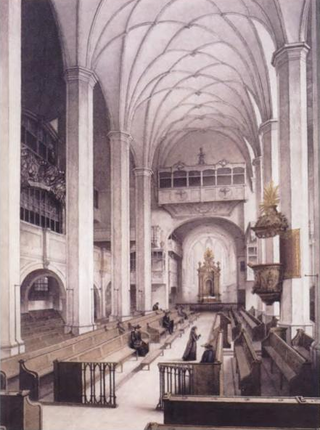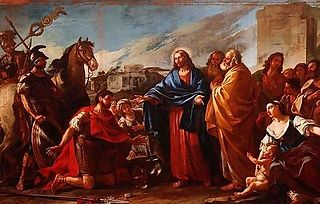Related Research Articles
The Bach-Werke-Verzeichnis is a catalogue of compositions by Johann Sebastian Bach. It was first published in 1950, edited by Wolfgang Schmieder. The catalogue's second edition appeared in 1990. An abbreviated version of that second edition, known as BWV2a, was published in 1998.
The year 1723 in music involved some significant events.
Throughout his life as a musician, Johann Sebastian Bach composed cantatas for both secular and sacred use. His church cantatas are cantatas which he composed for use in the Lutheran church, mainly intended for the occasions of the liturgical year.

The cantatas composed by Johann Sebastian Bach, known as Bach cantatas, are a body of work consisting of over 200 surviving independent works, and at least several dozen that are considered lost. As far as known, Bach's earliest cantatas date from 1707, the year he moved to Mühlhausen, although he may have begun composing them at his previous post in Arnstadt. Most of Bach's church cantatas date from his first years as Thomaskantor and director of church music in Leipzig, a position which he took up in 1723.

Erfreut euch, ihr Herzen, BWV 66.2, BWV 66, is a church cantata for Easter by Johann Sebastian Bach. He composed it for the Second Day of Easter in Leipzig and first performed it on 10 April 1724. He based it on his congratulatory cantata Der Himmel dacht auf Anhalts Ruhm und Glück, BWV 66.1, first performed in Köthen on 10 December 1718.
SalomonFranck, 6 March 1659 – 11 July 1725), was a German lawyer, scientist, and poet. Franck was working at Weimar at the same time as the composer Johann Sebastian Bach and he was the librettist of some of the best-known Bach cantatas.

Erforsche mich, Gott, und erfahre mein Herz, BWV 136 is a church cantata by Johann Sebastian Bach. Bach composed the cantata in 1723 in Leipzig to be used for the eighth Sunday after Trinity. He led the first performance on 18 July 1723.

Johann Sebastian Bach composed the church cantata Ich glaube, lieber Herr, hilf meinem Unglauben, BWV 109, in Leipzig for the 21st Sunday after Trinity and first performed it on 17 October 1723.

Vox Christi, Latin for Voice of Christ, is a setting of Jesus' words in a vocal work such as a Passion, an Oratorium or a Cantata. Conventionally, for instance in Protestant music of the Baroque era, the vox Christi is set for a bass voice.

Sie werden aus Saba alle kommen, BWV 65, is a church cantata by Johann Sebastian Bach. He composed it in 1724 in Leipzig for Epiphany and first performed it on 6 January 1724 as part of his first cantata cycle.
There are 52 chorale cantatas by Johann Sebastian Bach surviving in at least one complete version. Around 40 of these were composed during his second year as Thomaskantor in Leipzig, which started after Trinity Sunday 4 June 1724, and form the backbone of his chorale cantata cycle. The eldest known cantata by Bach, an early version of Christ lag in Todes Banden, BWV 4, presumably written in 1707, was a chorale cantata. The last chorale cantata he wrote in his second year in Leipzig was Wie schön leuchtet der Morgenstern, BWV 1, first performed on Palm Sunday, 25 March 1725. In the ten years after that he wrote at least a dozen further chorale cantatas and other cantatas that were added to his chorale cantata cycle.
In Johann Sebastian Bach's time, the election or inauguration of a new town council, normally an annual event, was celebrated with a church service. A cantata written for such occasion was indicated with the term Ratswahl or Ratswechsel. Bach composed such cantatas for Mühlhausen and for Leipzig. Five of these cantatas are entirely extant. One further cantata, BWV 193.2, lost part of its music, and there are another five that have only been known to exist, or for which only the text is extant.
Johann Sebastian Bach's chorale cantata cycle is the year-cycle of church cantatas he started composing in Leipzig from the first Sunday after Trinity in 1724. It followed the cantata cycle he had composed from his appointment as Thomaskantor after Trinity in 1723.
Picander's cycle of 1728–29 is a cycle of church cantata librettos covering the liturgical year. It was published for the first time in 1728 as Cantaten auf die Sonn- und Fest-Tage durch das gantze Jahr. Johann Sebastian Bach set several of these librettos to music, but it is unknown whether he covered a substantial part of the cycle. This elusive cycle of cantata settings is indicated as the composer's fourth Leipzig cycle, or the Picander cycle.
Johann Sebastian Bach worked at the ducal court in Weimar from 1708 to 1717. The composition of cantatas for the Schlosskirche on a regular monthly basis started with his promotion to Konzertmeister in March 1714.

On Trinity Sunday 27 May 1725 Johann Sebastian Bach had presented the last cantata of his second cantata cycle, the cycle which coincided with his second year in Leipzig. As director musices of the principal churches in Leipzig he presented a variety of cantatas over the next three years. New cantatas for occasions of the liturgical year composed in this period, except for a few in the chorale cantata format, are known as Bach's third cantata cycle. His next cycle of church cantatas, the Picander cycle, did not start before St. John's Day 24 June 1728.
The late church cantatas by Johann Sebastian Bach are sacred cantatas he composed after his fourth cycle of 1728–29. Whether Bach still composed a full cantata cycle in the last 20 years of his life is not known, but the extant cantatas of this period written for occasions of the liturgical year are sometimes referred to as his fifth cycle, as, according to his obituary, he would have written five such cycles – inasmuch as such cantatas were not late additions to earlier cycles, or were adopted in his oratorios.
References
- ↑ Dürr, Alfred; Jones, Richard D. P. (6 July 2006). "Introduction". The Cantatas of J. S. Bach: With Their Librettos in German-English Parallel Text. OUP Oxford. pp. 22–29. ISBN 978-0-19-929776-4.
- ↑ "Siehe eine Jungfrau ist schwanger BWV 1135". Bach Digital . Leipzig: Bach Archive; et al. 2020-08-24.
- ↑ "Himmelskönig, sei willkommen BWV 182". Bach Digital . Leipzig: Bach Archive; et al. 2020-05-13.
- ↑ Tatiana Shabalina "Recent Discoveries in St Petersburg and their Meaning for the Understanding of Bach’s Cantatas" pp. 77-99 in Understanding Bach 4, 2009